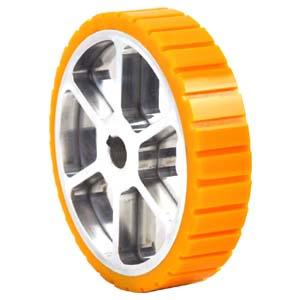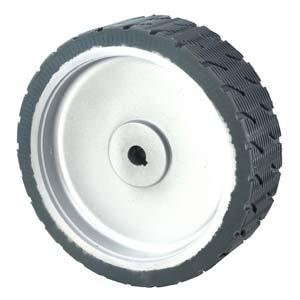Different between rubber agv driving wheels and pu agv driving wheels
10 Oct / 2023AGV (Automated Guided Vehicle) driving wheels play a crucial role in the transportation system as they bear the vehicle's weight and provide traction and control. Rubber and Polyurethane (PU) are two commonly used materials for AGV driving wheels. In this article, we will discuss the differences between rubber and PU AGV wheels based on several factors, including material properties, performance, durability, and cost.
Material Properties:
Rubber is a natural polymer derived from rubber trees or synthetic sources. It has high elasticity, excellent shock absorption, and low deformation under pressure. Rubber's properties allow it to have high friction with the surface, making it suitable for use in AGV Drive wheels. Additionally, rubber wheels provide better noise reduction and vibration damping compared to other materials. Rubber wheels come in different durometers (hardness), from very soft to very hard, to suit specific requirements.
Polyurethane (PU), on the other hand, is a synthetic material made by reacting polyols with isocyanates. PU wheels offer high load-bearing capacity, excellent wear resistance, and durability. PU is also resistant to oil, grease, and chemicals, which makes it ideal for harsh environments. PU wheels come in different hardness levels and can provide high traction on surfaces.
Performance:
In terms of performance, rubber wheels have higher coefficients of friction than PU wheels. This allows them to have better grip and traction on surfaces. Rubber wheels are relatively more slip-resistant, making them less prone to wheel slippage. They can also absorb shock better than PU wheels, providing better stability and handling when carrying heavy loads. However, rubber wheels tend to lose their grip over time due to wear and tear, and they may also leave skid marks on some surfaces.
PU wheels offer greater durability and longevity than rubber wheels. They can withstand high loads and are more resistant to wear and tear. PU wheels also maintain their shape and size better than rubber wheels, which means they are less prone to deform under heavy loads. Furthermore, PU wheels are capable of performing well in cold temperatures, making them suitable for refrigerated environments. PU wheels can provide good traction, but their coefficients of friction are slightly lower than those of rubber wheels. This may affect their performance on steep inclines or wet surfaces.
Durability:
Both rubber and PU wheels are durable, and they can last for several years with proper maintenance. However, PU wheels tend to be more durable than rubber wheels due to their resistance to abrasion, chemicals, and impact. Rubber wheels tend to wear out faster due to their softer nature, which makes them more susceptible to damage from sharp objects, cuts, and punctures. Additionally, rubber wheels can degrade when exposed to UV light, ozone, and extreme temperatures.
Cost:
The cost of AGV driving wheels varies depending on the material used, manufacturing process, and supplier. Generally, PU wheels tend to be more expensive upfront than rubber wheels. However, because of their durability, long lifespan, and low maintenance requirements, they may offer cost savings over time. Rubber wheels are less expensive upfront, but they require more frequent replacement, which can add up over time.
Conclusion:
In conclusion, both rubber and PU wheels have their strengths and weaknesses. Rubber wheels offer better grip and shock absorption but tend to wear out faster and leave skid marks. PU wheels offer greater durability and are resistant to abrasion, chemicals, and impact. However, they may not provide the same level of traction as rubber wheels.
When choosing between rubber and PU AGV driving wheels, consider your specific requirements, operating environment, load capacity, and budget. Consult with AGV manufacturers, engineers, and experts in the field to determine which type of wheel is best for your application.

